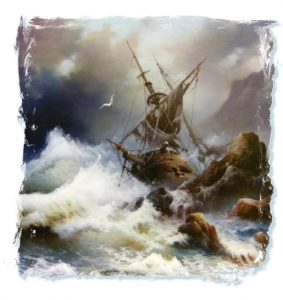“O, brave new world
that has such people in’t!” ― The Tempest
Sea Venture, the 300-ton flagship of the London Company, was the first purpose-built emigration ship. The hold was built with cabins, and the twenty-four canons were stationed on the main deck. On 02 June 1609, Sea Venture set sail from Plymouth, England, on her maiden voyage, part of the Third Supply mission, as the flagship of a nine-ship fleet destined for Jamestown Colony. Aboard were Edward Waters, a member of the London Company, which was organized for the purpose of colonizing Virginia, and John Graye Proctor.
The usual course was to sail as far south as the Canary Islands; at that latitude, the direction of the wind was from the West, which would have pushed them across the Atlantic. They would have then followed the chain of west indian islands to Florida and then up the Atlantic coast. With the West Indies firmly in the grip of the Spanish Empire, the English fleet turned Northwards into the open Atlantic. The intent was to bypass the Spanish threat and head directly for Virginia.
 On 24 July 1609, days from reaching Jamestown, the fleet ran into a strong storm, most likely a hurricane, and became separated. Sea Venture fought the storm for three days. Other ships of comparable size had survived such storms; the critical difference was that Sea Venture’s timbers had not had time to set, and the caulking was forced from between them. Despite the efforts to bail and jettison the ship’s guns to raise her buoyancy, the hold continued to leak, and the water level rose.
On 24 July 1609, days from reaching Jamestown, the fleet ran into a strong storm, most likely a hurricane, and became separated. Sea Venture fought the storm for three days. Other ships of comparable size had survived such storms; the critical difference was that Sea Venture’s timbers had not had time to set, and the caulking was forced from between them. Despite the efforts to bail and jettison the ship’s guns to raise her buoyancy, the hold continued to leak, and the water level rose.
Sir George Somers, Admiral of the Company, spied land on the morning of 25 July; the water in the hold had reached a depth of nine feet, and the passengers and crew were past the point of exhaustion. Admiral Somers had the ship driven into the reefs of what proved to be eastern Bermuda, allowing 150 people and one dog to be safely landed.
The survivors, who were disenchanted with this new world, were confined to a prisonlike camp for almost a year while they constructed two new ships, the Deliverance, and the Patience, from local cedar and the salvaged wreckage of the Sea Venture. On May 10, 1610, 142 survivors set sail for Virginia. On reaching Jamestown, less than two weeks later, they discovered that only 60 of the 500 or so who had preceded them to the colony had survived. Everyone boarded the ships to set sail back to England, the settlement of Jamestown being deemed unviable. They were intercepted by a relief fleet and relanded at the colony.
Edward Waters had remained in Bermuda to help hold possession of the island; John Graye Proctor was among the survivors who landed at Jamestown in 1610. Waters would finally reach his original destination in 1618.
William Shakespeare’s The Tempest was inspired by accounts of the wreck of the Sea Venture, the shipwreck that saved Jamestown, and ultimately the colonization of America.
While this is an interesting bit of history, how does it relate to the prompt of Origins? Three hundred eighty-eight years after the wreck of Sea Venture, a 10th great-grandson of Edward Waters, Jerrell Blackmon, married a 10th great-granddaughter of John Graye Proctor, Susan Black, in a small town in North Central Texas!
#52ancestors
